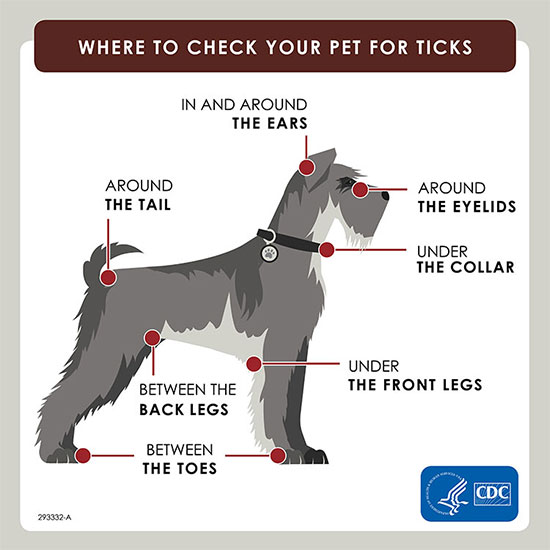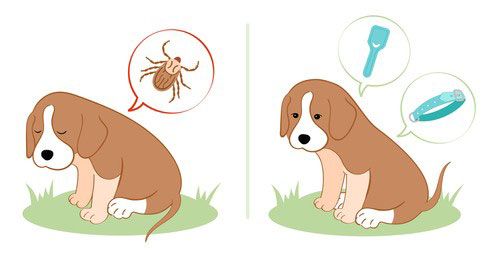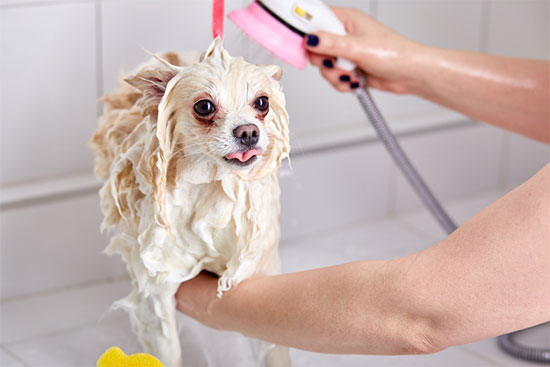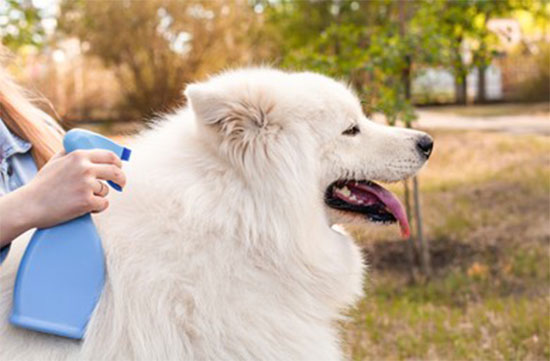
Ticks are common pests, with so many of them around the world. Apart from human beings and dogs, other animals that usually get infested by ticks include horses, cattle, sheep, or pigs. This article gives you everything you need to know about what causes ticks in dogs, as well as how to prevent ticks in dogs?
It’s not just your dog that ticks can affect; they’re also a huge problem for you. They can carry a wide range of dangerous bacteria to your dog’s health, and they often live on their host as well, making it difficult to get rid of them because there will always be some left behind!
The good news, though, is that veterinarians know about the various types of ticks out there, so you’ll have knowledge ahead of time if this becomes an issue in your home. Preventing tick problems before they happen might not only save time but also help keep our pets healthy too!
What causes ticks in dogs?
Your dog can get fleas from other flea-infested animals, such as a stray animal or your neighbor’s dog or cat or urban wildlife, mainly opossums and raccoons – went through your neighborhood and your yard. When these infestations happen in the yard and on pets, you can be sure that eggs have been laid there. Female adult fleas lay eggs all over the place like your garden, yard, trees, even in the grass in your yard, which developed more adults who then go after your pet!
Dogs are more prone to ticks because they’re often walking through the woods or high grass, and these ticks can undergo what’s called questing where ticks can crawl up on these overgrown shrubs, meadows with thick brush, generally, 18 to 24 inches off the ground and they basically hang out.
And when our dog walks by, or we walk by and brush up against these ticks, they dislodge and get onto us. They just wait for us to walk by and then they attach themselves to our skin. They can live without eating for over a year!
How To Prevent Ticks From Dogs?

Keep your dog away Where Ticks are Common
- Ticks live in places with dense, wooded vegetation. These include overgrown shrubs, thick brush, and places where the ground is covered with leaves.
- Ticks wait for animals to pass by them. Tick bites are dangerous. You should stay away from areas of vegetation that have a lot of low, thick underbrush.
- Ticks have heat sensors, and they can detect your dog’s body by it. They grab onto your dog’s fur as it walks by. Then they go through the coat to find skin and drink blood to fertilize their eggs.
- Please stay on the trail when you go outdoors for hiking, camping, or walking with your dog, and make sure they are with you. Don’t walk through the woods or long grass where ticks are common. If your pet runs away, be sure to check them for ticks when you get home.
Identifying the habitat of ticks in your yard

Your dog is likely spending some serious amounts of energy running around outside. Still, while they’re burning calories, ticks might also have been left behind by other animals who came into contact with them too.
- Ticks do not typically live in the open, so you are less likely to encounter them on your lawn. They tend to congregate near trees and shrubs where they can get shade from sunlight and humidity-rich leaf litter for breeding grounds.
- Raking up decaying leaves and trimming overgrown brush are easy ways to protect your yard from ticks.
- Keep an eye on the height of your lawn, as it should be cut below ankle level (18-24 inches off the ground) so that you don’t create a hospitable environment for ticks.
- To keep away rodents that may carry ticks, make sure your trash cans have strong lids to prevent them from getting in. Additionally, clear any rock piles and brushy cover around the can so there is nothing for them to create a nest.
- Ticks are a pest that loves hiding in bushes and under leaves. By trimming shrubs and low branches as well as raking up fallen leaves in your yard, you will remove all of the household factors which make them nice places for ticks to breed!
How To Check A Dog For Ticks

- Make sure you check your dog regularly for ticks after he’s been outside, especially during the tick season: spring, summer, and fall.
- Ticks are usually small, dark, and like to hide in deep and dark areas. They can be hard to spot on dogs who have long coats or darker fur colors, so getting your pup groomed will make the search easier!
- Run your hands over every inch of your dog, using the fingers as if they were teeth to comb through. Make sure you check under the dog’s collar, between their toes, behind the ears, and near any folds on his body – ticks love those hidden spots!
- If your dog has a tick, you can feel a small bump with your fingers when you run your hand over your dog.
- Do not pull the bump from your dog’s skin too fast. Stop and see what kind of bump it is before you do anything. It can be harmful to your dog if you pull a part of the tick’s body.
- Watch for any redness or irritation on your dog. This could be a sign that a tick has attached to the skin.
Tick Removal and Disposal
Removing ticks from the dog’s skin can be a tricky process. You should wear rubber gloves when removing them to avoid any potential injury or infection.
The safest way of getting rid of these pests is by using tweezers, which you can purchase at your local pet store for around $5-$10 in order to help remove these pesky critters without leaving parts behind that may cause an eventual infection later on.
- Use fine-tipped tweezers and grab the tick close to the skin with firm but gentle pressure. Pull steadily until all of its body parts have been removed; avoid crushing or squeezing because this can cause infection in dogs after removal.
- After removing the ticks, clean your pup’s skin with soap and warm water or apply a dab of triple antibiotic ointment.
If you’re not sure how to remove a tick from your dog, it is best to get the help of a veterinarian.
Topical Insecticides to Protect Your Dog
Topical medication is a very popular way to get rid of fleas and ticks. You can purchase these topical insecticides from your vet, a pet store, or online. Apply those insecticides directly to your dog’s skin, usually between the shoulder blades or at the base of the neck. This process is also called “spot-ons.” A one-time dose is effective at keeping parasites away for 30 to 90 days!
Must read all labels carefully, and if you have any doubts about what the label says or how to apply it correctly, be safe and consult your vet before applying.
Topical insecticides spread over the dog’s entire body, depositing into the sweat glands of their skin where it can release its active ingredient for several weeks, even if your dog is bathed or goes swimming.
The Best Flea And Tick Medicines For Dogs In 2021
- Advantage Multi Topical Solution for Dogs
- Frontline Plus Flea & Tick Spot Treatment
- Bravecto Topical Solution for Dogs
- K9 Advantix II Flea & Tick Spot Treatment
Here is How to Apply Flea & Tick Topical Treatments
Apply Tick Collar

You can use tick collars instead of topical flea medications, as they’re a popular choice and highly convenient to use. The chemical in flea collars is strong enough to repel fleas (and sometimes ticks) from dogs or cats. The chemicals will last on a dog or cat for 3 to 4 months, so you must change it timely for optimal protection.
Pyrethrin is the most common ingredient in these products, which can be toxic if ingested by children or pets that frequently lick their fur.
Flea and tick collars are comparatively inexpensive and a great way to protect your cat or dog, but they often have an unpleasant smell and can be irritating to your pet.
Many dog owners have been unaware of the importance of a collar until it becomes too late. For example, many collars lose their effectiveness when they get wet and should not be used with dogs that spend time in the water. To ensure your dog does not chew on its collar, you must cut off any excess length of the collar.
Best Flea Collars for Dogs
- Hartz UltraGuard Pro Reflective Flea & Tick Collar for Dogs ( Best Overall)
- Sentry Flea & Tick Collar for Dogs (Best for Prevention)
- Seresto Flea & Tick Collar for Dogs ( Large & Small Breeds)
- Adams Flea and Tick Collar For Dogs (Best for Large Dogs)
- Vet’s Best Flea and Tick Repellent Collar for Dogs (Best Natural)
- TevraPet ProAct Flea and Tick Collar for Dogs (Best Waterproof)
Apply Flea And Tick Shampoo

Flea and tick shampoos are capable of washing away adult fleas and their eggs for a short time, but they may not stop an infestation or keep the fleas from returning. The typical ingredients in these products are Peppermint Oil, Eugenol, or pyrethrins which kill fleas, larvae, flea eggs, ticks, and even mosquitos on contact. These products primarily work to rid your dog of ticks he already has – although some have lingering anti-tick effects! You can find medicated shampoo at most grocery stores as well as pet shops.
Wet their fur before lathering it up with shampoo, starting from the dog’s head then working back towards its tailbone. Leave on for about five to ten minutes(according to level instruction), then rinse thoroughly and towel dry until there isn’t any more water left between their toes or feathers.
best flea and tick shampoo for dogs
- Adams Plus Flea & Tick Shampoo (Best Overall)
- Arava Flea & Tick Control Dog & Puppy Shampoo (Best for Puppies)
- Richard’s Organics Flea and Tick Shampoo for Dogs (Best Organic)
- Sentry Flea & Tick Oatmeal Hawaiian Ginger Shampoo for Dogs (Best for Sensitive Skin)
Use A Tick Spray

As an animal lover, there’s nothing worse than bringing your dog to a park or field and finding ticks on them. However, if you are taking your pet into wooded areas where tick infestation is known to be higher, then tick sprays could be the best solution.
Tick spray is a relatively inexpensive method for controlling fleas and ticks on your cat or dog. Typically, these products contain pyrethrins and other ingredients that kill fleas, ticks, and even mosquitoes, flies, and gnats.
Application of sprays is relatively easy, but make sure you cover every inch of your dog’s body and tendrils with the repellant. Avoid getting it in their eyes or ears as well! Use a cotton ball to apply the product around your dog’s eyes and ears.
There are also a lot of Natural products available that use Peppermint Oil, Eugenol (Clove Extract), Sodium Lauryl Sulfate (Plant Derived), or other plant extracts to kill fleas, flea eggs, and ticks. You can apply it directly on your dogs of 12 weeks or older.
Flea sprays can last for a long time (up to several months) if the pet stays dry and does not wash off.
Best Flea And Tick Spray For Dogs
- vet’s best flea and tick home spray (Best Overall)
- hartz nature’s shield flea and tick home spray
- Natural Care Dog & Cat Flea & Tick Spray
Tips
- Many dangers can arise when pets take any medication, and this is especially true with chemical pesticides. Always consult your veterinarian before starting a new treatment or introducing chemicals into the animals’ lives.
- Ticks are known carriers of disease and can transmit it to both you and your pet. In most cases, the tick needs to have been attached and feeding on you or your dog for over twenty-four hours to transmit the disease. So make sure that after being in a potentially infected area or coming into contact with ticks, you check yourself and other pets immediately.
- These are all separate ways to prevent ticks & fleas from getting on your dog. If you use more than one method combined, the dog might be poisoned.
- Read this Tick Management Handbook
References
- http://pets.webmd.com/dogs/guide/dog-ticks-and-fleas
- https://web.uri.edu/tickencounter/ticksmart/
- https://www.petmd.com/dog/parasites/evr_dg_10_ways_to_stop_ticks_from_biting_your_dog
Read More:



